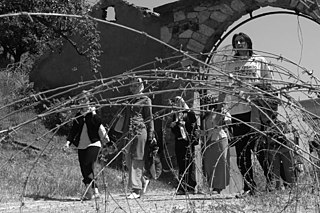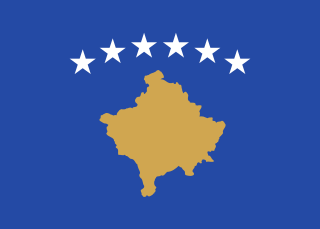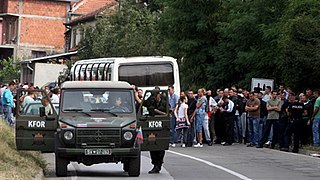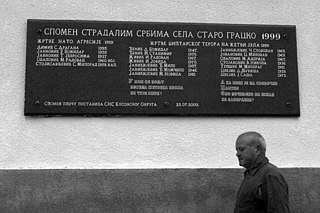
The United Nations Interim Administration Mission in Kosovo is the officially mandated mission of the United Nations in Kosovo. The UNMIK describes its mandate as being to "help the United Nations Security Council achieve an overall objective, namely, to ensure conditions for a peaceful and normal life for all inhabitants of Kosovo and advance regional stability in the Western Balkans."

Mitrovica, also referred to as South Mitrovica, is a city in northern Kosovo and administrative center of the District of Mitrovica. In 2013, the city was split into two municipalities, South Mitrovica and North Mitrovica. Settled 10 km (6.2 mi) from Ujmani/Gazivoda Lake, on the confluence of the rivers Ibër, Sitnicë, Lushta, and Trepça, the city is surrounded by the mountains of Kopaonik, Rogozna, Mokna, and Çyçavica. According to the 2011 Census, the two municipalities had 97,686 inhabitants of which 85,360 reside in south and 12,326 in north.

The Kosovo Force (KFOR) is a NATO-led international peacekeeping force in Kosovo. Its operations are gradually reducing until Kosovo's Security Force, established in 2009, becomes self-sufficient.

The Kosovo Police is the national policing law enforcement agency of Kosovo. It was established in 1999 and took its current form with the 2008 police law. It consists of five departments and eight regional directorates and is represented at the political level by the Ministry of Internal Affairs and Public Administration of the Republic of Kosovo.

The Kosovo Protection Corps was a civilian emergency services organization in Kosovo active from 1999 until 2009.

On 17–18 March 2004, violence erupted in the partitioned town of Mitrovica, Kosovo, leaving hundreds wounded and at least 14 people dead. The unrest was precipitated by reports in the Kosovo Albanian media which falsely claimed that three Kosovo Albanian boys had drowned after being chased into the Ibar River by a group of Kosovo Serbs. UN peacekeepers and NATO troops scrambled to contain a gun battle between Serbs and Albanians. Serbs call the event the March Pogrom, while the Albanians call it the March Unrest.

NorthKosovo ; also known as the Ibar Kolašin ; earlier Old Kolašin,, is a region in the northern part of Kosovo, generally understood as a group of four municipalities with ethnic Kosovo Serbs majority: North Mitrovica, Leposavić, Zvečan and Zubin Potok.

The flag of the Republic of Kosovo was adopted by the Assembly of the Republic of Kosovo immediately following the unilateral declaration of independence of Kosovo on 17 February 2008. The flag design emerged from an international competition, organized by an informal group from the Provisional Institutions of Self-Government known as the Kosovo Unity Team, which attracted almost one thousand entries. The winning design was proposed by Muhamer Ibrahimi. It shows six white stars in an arc above a golden map of Kosovo, all on a blue field. The stars symbolize Kosovo's six major ethnic groups: Albanians, Serbs, Bosniaks, Turks, Romani, and Gorani.
The 2008 Kosovo declaration of independence, which proclaimed the Republic of Kosovo to be a state independent from Serbia, was adopted at a meeting held on 17 February 2008 by 109 out of the 120 members of the Assembly of Kosovo, including the Prime Minister of Kosovo, Hashim Thaçi, and by the President of Kosovo, Fatmir Sejdiu. It was the second declaration of independence by Kosovo's Albanian-majority political institutions; the first was proclaimed on 7 September 1990.

The 2008 unrest in Kosovo followed Kosovo's declaration of independence on February 17, 2008. Some Kosovo Serbs opposed to secession boycotted the move by refusing to follow orders from the central government in Pristina and attempted to seize infrastructure and border posts in Serb-populated regions. There were also sporadic instances of violence against international institutions and governmental institutions, predominantly in North Kosovo.

Clashes between the Republic of Kosovo and ethnic Serbs in northern Kosovo began on 25 July 2011 when the Kosovo Police crossed into the Serb-controlled municipalities of North Kosovo, to control several administrative border crossings. This was done without the Kosovo Police consulting either Serbia or Kosovo Force (KFOR)/EULEX. Though tensions between the two sides eased somewhat after the intervention of NATO's KFOR forces, they remained high amid concern from the European Union, which also blamed Kosovo for the unilateral provocation. On 19 April 2013, an agreement was signed in Brussels between representatives of Kosovo and Serbia. The 15-point document granted devolved powers to North Kosovo regarding economic development, education, healthcare and urban planning, and several mechanisms that allowed a certain autonomy in justice, policing and electoral matters.

Serbian National Council of Kosovo and Metohija is an elected political and coordinating body acting as a representative of Serbs of Kosovo.

The Staro Gracko massacre was the mass killing of 14 Kosovo Serb farmers in the village of Staro Gracko in the Kosovo municipality of Lipjan on 23 July 1999. The killings occurred after Yugoslav troops withdrew from the region in the aftermath of the Kosovo War. The massacre is the worst single crime in Kosovo since the conflict ended in June 1999. As of 2019 the perpetrators of the killings have never been found and held accountable.

Mitrovica District is one of the unified seven districts of Kosovo. Its administrative center and the largest city is Mitrovica. The district borders on the District of Peja to the south-west, the District of Pristina to the south-east and east, and the Republic of Serbia to the north and northwest.

The 2000 unrest in Kosovo was the result of the United Nations Interim Administration adopting Resolution 1244 on 10 June 1999. The unrest was fought between the Kosovo Force (KFOR), Kosovar Albanians, and Kosovar Serbs. It lasted somewhere from February 16, 2000 – June 6, 2000. An unknown number of Kosovar Albanians and Kosovar Serbs died along with an unknown number injured, while 1 Russian KFOR soldier died from shot wounds and UNMIK vehicles were burned during the unrest.

The Multinational Specialized Unit (MSU), is a unit of the Italian Carabinieri, dedicated to the military missions abroad, including the military and civilian police tasks, peacekeeping operations, crowd and riot control.
Dragiša Milović is a Kosovo Serb politician. He was the mayor of Zvečan, a predominantly Serb community in the disputed territory of Kosovo, from 2002 to 2013, serving as a member of the Democratic Party of Serbia (DSS). In 2021, he was re-elected to the same position as a candidate of the Serb List (SL).
Milan Ivanović is a Kosovo Serb medical doctor, administrator, and politician. He was a prominent figure in northern Kosovo politics for the first decade after the 1998–99 Kosovo War. Ivanović was for many years the leader of the Serbian National Council of Northern Kosovo and Metohija and has been a vocal opponent of engagement with the post-1999 governing authorities in Priština. He is no relation to the late Oliver Ivanović.

United Nations Administered Kosovo refers to the period between 1999 and 2008 when the United Nations Interim Administration Mission in Kosovo was directly responsible for the governance of Kosovo. This period began on 10 June 1999 with the passing of United Nations Security Council Resolution 1244 and effectively ended on 17 February 2008 with the unilateral declaration of independence of Kosovo.
The Kosovo Transitional Council,, was an advisory body that existed in Kosovo between July 1999 and November 2001 during the period that the United Nations was directly responsible for the governance of Kosovo. The council was replaced by the Assembly of Kosovo following elections held in November 2001.


















